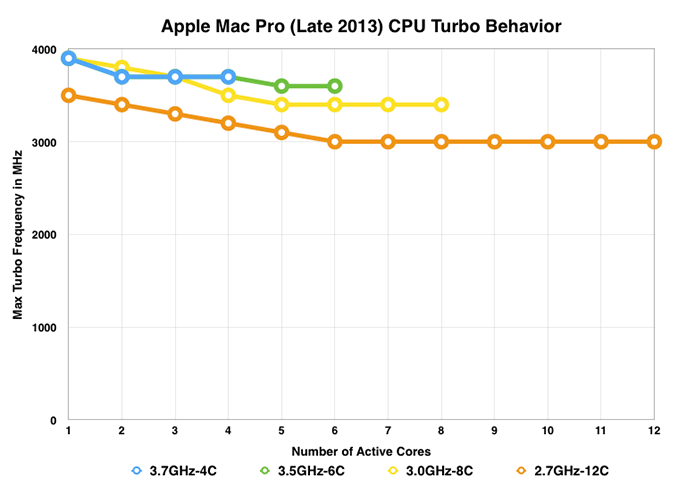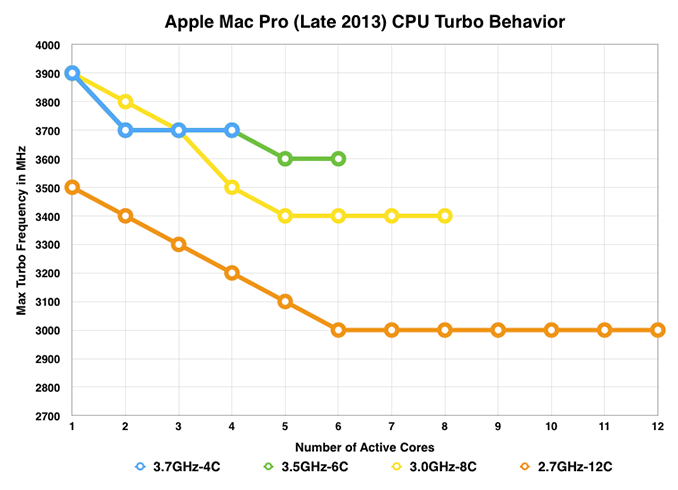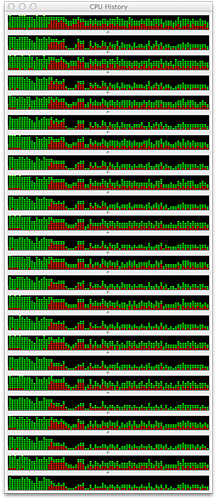The Mac Pro Review (Late 2013)
by Anand Lal Shimpi on December 31, 2013 3:18 PM ESTCPU Choices
Had I gotten around to publishing my rMBP review prior to this one you would’ve seen my praise Apple’s CPU selection abilities as of late. Outfitting all 15-inch rMBPs with Crystalwell was a very wise move on Apple’s part. With the Mac Pro the CPU selection is good, but the decision of what to buy is far more complex than in any other product line.
The Mac Pro not only serves as Apple’s ultra high end Mac, but it’s the only option if your needs exceed that of an iMac or 15-inch MacBook Pro. Literally anyone who needs more performance than Apple offers in an all-in-one or a notebook inevitably is pushed to consider the Mac Pro. With a relatively broad professional audience in mind, Apple offers more CPU options for the Mac Pro than on any other shipping Mac:
| Mac Pro (Late 2013) CPU Options | ||||||
| Intel CPU | Xeon E5-1620 v2 | Xeon E5-1650 v2 | Xeon E5-1680 v2 | Xeon E5-2697 v2 | ||
| Cores / Threads | 4 / 8 | 6 / 12 | 8 / 16 | 12 / 24 | ||
| CPU Base Clock | 3.7GHz | 3.5GHz | 3.0GHz | 2.7GHz | ||
| Max Turbo (1C) | 3.9GHz | 3.9GHz | 3.9GHz | 3.5GHz | ||
| L3 Cache | 10MB | 12MB | 25MB | 30MB | ||
| TDP | 130W | 130W | 130W | 130W | ||
| Intel SRP | $294 | $583 | ? | $2614 | ||
| Apple Upgrade Cost (Base Config) | - | +$500 | +$2000 | +3500 | ||
| Apple Upgrade Cost (High End Config) | - | - | +$1500 | +3000 | ||
There are four CPU options, each with varying core counts. The more cores you get, the lower your base CPU frequency is. In the old days, that would be the end of the discussion - you either choose more cores or more frequency, a tradeoff that is ultimately determined by your workload. Starting with its Nehalem architecture back in 2008, Intel introduced two key technologies that changed the face of multicore on the desktop: power gating and turbo boost. The former is a technology that can almost entirely remove power to a core (both active and leakage) when idle, while the second takes advantage of that freed up thermal budget to drive any active core(s) at higher frequencies. Subsequent implementations of Intel’s Turbo Boost technology have scaled the aggressiveness of this opportunistic frequency scaling, but the basic principle remains the same.
Apple advertises core count and base frequency for all of the Mac Pro CPU options, but to really understand what you’re getting yourself into you need to look at each CPU’s max turbo states vs. number of active cores. Neither Apple nor Intel do a great job of publicly exposing this information, Apple avoids doing so in order to keep things clean/simple, and Intel avoids doing so because perhaps it’s fun? Either way I’ve compiled the data on the four CPU options into the charts below.
I've left base clocks out of the graphs although you can see them noted in the legend at the bottom of each chart.
This first chart has the y-axis starting at 0MHz, but the next one is the more interesting as it starts at 2.7GHz and better illustrates/exaggerates the sort of frequency tradeoff you can expect vs. core count:
The 4, 6 and 8 core CPU options all offer the same peak single core frequency (3.9GHz). This is very important as single threaded performance remains the gate for system responsiveness outside of thread heavy applications. The 12-core CPU sacrifices around 10% of this peak single core performance.
Early on the 8-core CPU holds the advantage over the rest, being able to hit a higher 2-core max turbo. The octa-core’s crossover point happens at 3 active cores, beyond this point the quad and six core CPUs maintain a slight max turbo advantage.
The key takeaway here is that more cores isn’t necessarily better. You need to weigh the needs of your applications against the number of cores in your system. There is no one-size-fits-all answer here. For kicks I looked at the CPU load for a handful of my benchmarks:
![]()
![]()
![]()
Application version seems to have a huge impact on threading. Running our Photoshop benchmark on CS5 vs. CS6 is the difference between loading 2 - 8 cores vs. 3 - 10. The same is true if I compare Final Cut Pro 10.0 vs. 10.1; the latest version from Apple (optimized for the new Mac Pro), makes great use of all 12 cores/24 threads. Workload also has an impact. I took our old Final Cut Pro 10.0 benchmark (1080p) and ran it on 10.1, saw a maximum of 1217% CPU usage. I ran our new 4K benchmark on 10.1 and saw nearly full virtual core utilization (2114% CPU usage).
![]()
Final Cut Pro 10.0 - 1080p Benchmark
![]()
Final Cut Pro 10.1 - 1080p Benchmark
![]()
Final Cut Pro 10.1 - 4K Benchmark
Offline 3D rendering applications typically have the easiest time of chewing up tons of cores, while many others are likely better suited by having fewer cores running at a higher frequency. There's also a serious multitasking benefit if you're the type of person that runs multiple thread heavy workloads in parallel. It's pretty nice having a fairly responsive system while rendering a beefy 4K project in Final Cut Pro. The responsiveness comes courtesy of having a ton of cores in addition to extremely fast IO. That PCIe SSD definitely comes in handy.
If you want the best balance of heavily threaded performance without sacrificing performance in lighter workloads, the 8-core configuration seems to be the best bet. There are definitely bragging rights associated with the 12-core system, but unless you absolutely need a ton of cores you’re likely better suited by the 8-core configuration.













267 Comments
View All Comments
zepi - Wednesday, January 1, 2014 - link
How about virtualization and for example VT-d support with multiple gpu's and thunderbolts etc?Ie. Running windows in a virtual machine with half a dozen cores + another GPU while using rest for the OSX simultaneously?
I'd assume some people would benefit of having both OSX and Windows content creation applications and development environments available to them at the same time. Not to mention gaming in a virtual machine with dedicated GPU instead of virtual machine overhead / incompatibility etc.
japtor - Wednesday, January 1, 2014 - link
This is something I've wondered about too, for a while now really. I'm kinda iffy on this stuff, but last I checked (admittedly quite a while back) OS X wouldn't work as the hypervisor and/or didn't have whatever necessary VT-d support. I've heard of people using some other OS as the hypervisor with OS X and Windows VMs, but then I think you'd be stuck with hard resource allocation in that case (without restarting at least). Fine if you're using both all the time but a waste of resources if you predominantly use one vs the other.horuss - Thursday, January 2, 2014 - link
Anyway, I still would like to see some virtualization benchs. In my case, I can pretty much make it as an ideal home server with external storage while taking advantage of the incredible horse power to run multiple vms for my tests, for development, gaming and everything else!iwod - Wednesday, January 1, 2014 - link
I have been how likely we get a Mac ( Non Pro ) Spec.Nvidia has realize those extra die space wasted for GPGPU wasn't worth it. Afterall their main target are gamers and gaming benchmarks. So they decided for Kepler they have two line, one for GPGPU and one on the mainstream. Unless they change course again I think Maxwell will very likely follow the same route. AMD are little difference since they are betting on their OpenCL Fusion with their APU, therefore GPGPU are critical for them.
That could means Apple diverge their product line with Nvidia on the non Professional Mac like iMac and Macbook Pro ( Urg.. ) while continue using AMD FirePro on the Mac Pro Line.
Last time it was rumoured Intel wasn't so interested in getting a Broadwell out for Desktop, the 14nm die shrink of Haswell. Mostly because Mobile / Notebook CPU has over taken Desktop and will continue to do so. It is much more important to cater for the biggest market. Not to mention die shrink nowadays are much more about Power savings then Performance Improvements. So Intel could milk the Desktop and Server Market while continue to lead in Mobile and try to catch up with 14nm Atom SoC.
If that is true, the rumor of Haswell-Refresh on Desktop could mean Intel is no longer delaying Server Product by a single cycle. They will be doing the same for Desktop as well.
That means there could be a Mac Pro with Haswell-EP along with Mac with a Haswell-Refresh.
And by using Nvidia Gfx instead of AMD Apple dont need to worry about Mac eating into Mac Pro Market. And there could be less cost involve with not using a Pro Gfx card, only have 3 TB display, etc.
words of peace - Wednesday, January 1, 2014 - link
I keep thinking that if the MP is a good seller, maybe Apple could enlarge the unit so it contains a four sided heatsink, this could allow for dual CPU.Olivier_G - Wednesday, January 1, 2014 - link
Hi,I don't understand the comment about the lack of HiDPI mode here?
I would think it's simply the last one down the list, listed as 1920x1080 HiDPI, it does make the screen be perceived as such for apps, yet photos and text render at 4x resolution, which is what we're looking for i believe?
i tried such mode on my iMac out of curiosity and while 1280x720 is a bit ridiculously small it allowed me to confirm it does work since OSX mavericks. So I do expect the same behaviour to use my 4K monitor correctly with mac pro?
Am I wrong?
Gigaplex - Wednesday, January 1, 2014 - link
The article clearly states that it worked at 1920 HiDPI but the lack of higher resolutions in HiDPI mode is the problem.Olivier_G - Wednesday, January 1, 2014 - link
Well no it does not state that at all I read again and he did not mention trying the last option in the selector.LumaForge - Wednesday, January 1, 2014 - link
Anand,Firstly, thank you very much for such a well researched and well thought out piece of analysis - extremely insightful. I've been testing a 6 core and 12 core nMP all week using real-life post-production workflows and your scientific analysis helps explain why I've gotten good and OK results in some situations and not always seen the kinds of real-life improvements I was expecting in others.
Three follow up questions if I may:
1) DaVinci Resolve 10.1 ... have you done any benchmarking on Resolve with 4K files? ... like FCP X 10.1, BMD have optimized Resolve 10.1 to take full advantage of split CPU and GPU architecture but I'm not seeing the same performance gains as with FCP x 10.1 .... wondering if you have any ideas on system optimization or the sweet spot? I'm still waiting for my 8 core to arrive and that may be the machine that really takes advantage of the processor speed versus cores trade-off you identify.
2) Thunderbolt 2 storage options? ... external storage I/O also plays a significant role in overall sustained processing performance especially with 4K workflows ... I posted a short article on Creative Cow SAN section detailing some of my findings (no where as detailed or scientific as your approach I'm afraid) ... be interested to know your recommendations on Tbolt2 storage.
http://forums.creativecow.net/readpost/197/859961
3) IP over Tbolt2 as peer-to-peer networking topology? ... as well as running the nMPs in DAS, NAS and SAN modes I've also been testing IP over Tbolt2 .... only been getting around 500 MB/s sustained throughput between two nMPs ... if you look at the AJA diskwhack tests I posted on Creative Cow you'll see that the READ speeds are very choppy ... looks like a read-ahead caching issue somewhere in the pipeline or lack of 'Jumbo Frames' across the network ... have you played with TCP/IP over Thunderbolt2 yet and come to any conclusions on how to optimize throughput?
Keep up the good work and all the best for 2014.
Cheers,
Neil
modeleste - Wednesday, January 1, 2014 - link
I noticed that the Toshiba 65" 4k TV is about the same price as the Sharp 32" The reviews seem nice.Does anyone have any ide what the issues would be with using this display?